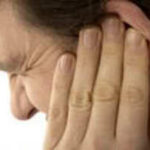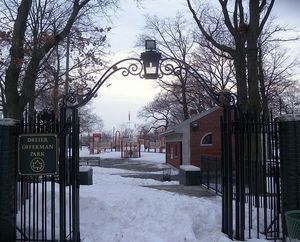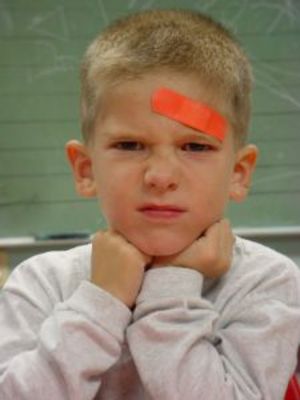Hearing loss occurs when there is loss of sound sensitivity produced by an abnormality anywhere in the auditory system. A wide variety of conditions can cause hearing loss, including otosclerosis, cholesteatoma, and others. While physicians can sometimes identify the causes of hearing loss, in some cases the causes are unknown, or idiopathic.
Conductive hearing loss occurs when sound waves are prevented from passing from the air to the fluid-filled inner ear. This may be caused by a variety of problems including buildup of cerumen, infection, fluid in the middle ear, a punctured eardrum, or fixation of the ossicles. Other causes include scarring, narrowing of the ear canal, tumors in the middle ear, and perforation of the tympanic membrane. Once the cause is found and removed or treated, hearing usually is restored.
Sensorineural hearing loss develops when the auditory nerve or hair cells in the inner ear are damaged. The source may be located in the inner ear, the nerve from the inner ear to the brain, or in the brain. Sensorineural hearing loss frequently occurs as a result of the aging process in the form of presbycusis, which is a gradual loss occurring in both ears. Tumors such as acoustic neuromas can lead to sensorineural hearing losses, as can viral infections, Meniere’s disease, meningitis, and cochlear otosclerosis.
Sensorineural hearing loss can also be the result of repeated, continuous loud noise exposure, certain toxic medications, or an inherited condition. Generally, it is non-reversible however there has been great progress in uncovering the genes responsible for a number of forms of congenital hearing impairments/ deafness, and this genetic research may in time lead to therapies for some congenital causes of hearing loss. The Weber and Rinne tuning fork tests can distinguish between conductive and sensorineural hearing losses.
The Weber test is based on the principle that the signal, when transmitted by bone conduction, will be localized to the better hearing ear or the ear with the greatest conductive deficit. The test can determine the type of hearing impairment when the two ears are affected to different degrees. The stem of a vibrating tuning fork is placed on the skull in the midline, and the patient is asked to indicate in which ear the sound is heard.
The usual location described is for placement on the forehead; but better locations are the nasal bones or teeth when a stronger bone conduction stimulus is required. In unilateral hearing losses, lateralization to the poorer-hearing ear indicates an element of conductive impairment in that ear. Lateralization to the better-hearing ear suggests that the problem in the opposite ear is sensorineural.
The Rinne test is probably the most commonly used tuning fork test. The Rinne test is a comparison of the patient’s hearing sensitivity by bone conduction versus air conduction. A normal individual will perceive the air conducted sound as louder or the same as bone conducted sound. Proper placement of the tuning fork in each situation is important. When testing by bone conduction, the stem fork should be placed firmly on the mastoid, as near to the posterosuperior edge of the ear canal as possible.
The stem should not touch the auricle of the external canal, which should be held to the side by the examiner’s fingers. Touching the external ear itself could give false results due to vibration of the auricle. When testing by air conduction, the fork is held about 2.5 cm lateral to the tragus. In the Rinne test, when the conduction mechanism is normal in an ear (that is, in individuals with normal hearing and in those with sensorineural hearing impairment), air conduction will be heard better than bone conduction as it is a more efficient means of sound transmission.
This finding is termed a positive Rinne. Bone conduction will be heard better than air conduction when there is a deficit in the conduction mechanism and is referred to as a negative Rinne. A conductive deficit of more than 15 db reverses the tuning fork responses (that is, bone conduction is better than air conduction) at 512 Hz. When testing by bone conduction, the examiner should not forget to have the patient remove his or her eyeglasses: the earpiece can interfere with proper placement of the stem of the tuning fork or give inappropriate conduction or vibratory information.
Although tuning fork tests allow the examiner to identify a conductive versus a sensorineural loss, and in some cases lateralize the symptomatic ear, it does not evaluate the degree of impairment or the effects of that impairment on speech understanding.




